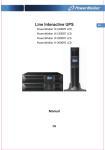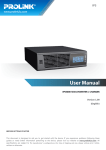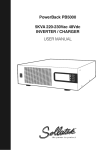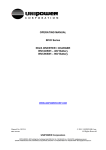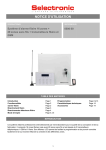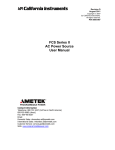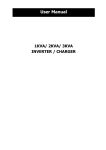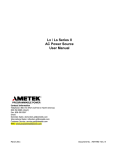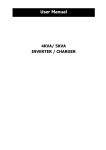Download User manual - PowerWalker UPS
Transcript
EN User manual POWERWALKER INVERTER 3000 PSW EN CONTENTS EN ABOUT THIS MANUAL ...................................................................................................................................... 1 Purpose ............................................................................................................................................................ 1 Scope ............................................................................................................................................................... 1 IMPORTANT SAFETY INSTRUCTIONS ............................................................................................................ 1 General Precautions ........................................................................................................................................ 1 Personal Precautions ....................................................................................................................................... 2 INSTALLATION ................................................................................................................................................... 3 Unpacking and Inspection................................................................................................................................ 3 Basic Configuration .......................................................................................................................................... 3 Batteries ........................................................................................................................................................... 5 Battery Cable Size ........................................................................................................................................... 5 DC Disconnect and Over-Current Protection .................................................................................................. 5 Battery Cable Connection ................................................................................................................................ 6 AC Cable Size .................................................................................................................................................. 6 AC Connections ............................................................................................................................................... 7 OPERATION ........................................................................................................................................................ 8 Front Panel and Configuration Switch ............................................................................................................. 8 Indicator & Alarm .............................................................................................................................................. 9 Operating Indicators....................................................................................................................................... 10 Setting Indicators ........................................................................................................................................... 11 SPECIFICATIONS ............................................................................................................................................. 12 Table 5 Line Mode Specifications .................................................................................................................. 12 Table 6 Invert Mode Specifications ................................................................................................................ 13 Table 7 Charge Mode Specifications ............................................................................................................. 14 Table 8 Approximate Back-up Times ............................................................................................................. 15 Table 9 General Specifications ...................................................................................................................... 15 Table 10 Fault code/ Audible alarm................................................................................................................ 16 TROUBLE SHOOTING ..................................................................................................................................... 17 ABOUT THIS MANUAL Purpose The purpose of this manual is to provide explanations and procedures for installing, operating and troubleshooting for the unit. This manual should be read carefully before installations and operations. Please retain this manual for future reference. Scope This document defines the functional requirements of the unit, intended for worldwide use in electronic processing equipment. All manuals are applicable under all operating conditions when installed in the End Use system, unless otherwise stated. IMPORTANT SAFETY INSTRUCTIONS WARNING: This chapter contains important safety and operating instructions. Read and keep this User Guide for future reference. General Precautions 1. Before using the unit, read all instructions and cautionary markings on: (1) The unit (2) the batteries (3) all appropriate sections of this manual. 2. CAUTION --To reduce risk of injury, charge only deep-cycle lead acid type rechargeable batteries. Other types of batteries may burst, causing personal injury and damage. 3. Do not expose the unit to rain, snow or liquids of any type. The unit is designed for indoor use only. Protect the unit from splashing if used in vehicle applications. 4. Do not disassemble the unit. Take it to a qualified service center when service or repair is required. Incorrect re-assembly may result in a risk of electric shock or fire. 5. To reduce risk of electric shock, disconnect all wiring before attempting any maintenance or cleaning. Turning off the unit will not reduce this risk. 6. CAUTION --Battery are not already installed by the supplier only a qualified professional (e.g. service person) may install the Inverter. 7. WARNING: WORKING IN VICINITY OF A LEAD ACID BATTERY IS DANGEROUS. BATTERIES GENERATE EXPLOSIVE GASES DURING NORMAL OPERATION. Provide ventilation to outdoors from the battery compartment. The battery enclosure should be designed to prevent accumulation and concentration of hydrogen gas in “pockets” at the top of the compartment. Vent the battery compartment from the highest point. A sloped lid can also be used to direct the flow to the vent opening location. 8. NEVER charge a frozen battery. 9. No terminals or lugs are required for hook-up of the AC wiring. AC wiring must be no less than 12 AWG o o gauge copper wire and rated for 75 C or higher. Battery cables must be rated for 75 C or higher and should be no less than table 1. Crimped and sealed copper ring terminal lugs with a 5/16 hole should be used to connect the battery cables to the DC terminals of the unit. Soldered cable lugs are also acceptable. 10. Be extra cautious when working with metal tools on, or around batteries. The potential exists to drop a 1 EN tool and short-circuit the batteries or other electrical parts resulting in sparks that could cause an explosion. 11. No AC or DC disconnects are provided as an integral part of this unit. Both AC and DC disconnects must be provided as part of the system installation. See INSTALLATION section of this manual. 12. Fuses (F40AL, 32VDC*6) are provided as the over current protection of the battery supply. 13. GROUNDING INSTRUCTIONS -This battery charger should be connected to a grounded permanent wiring system. For most installations, the Ground Lug should be bonded to the grounding system at one (and only one point) in the system. All installations should comply with all national and local codes and ordinances. 14. AVOID AC output short-circuit; avoid DC input short-circuit and do not connect the mains while DC input short-circuit 15. Warning: The maintenance information is only to service persons Personal Precautions 1. Someone should be within range of your voice to come to your aid when you work near batteries. 2. Have plenty of fresh water and soap nearby in case battery acid contacts skin, clothing, or eyes. 3. Wear complete eye protection and clothing protection. Avoid touching eyes while working near batteries. Wash your hands when done. 4. If battery acid contacts skin or clothing, wash immediately with soap and water. If acid enters eyes, immediately flood eyes with running cool water for at least 15 minutes and get medical attention immediately. 5. Baking soda neutralizes lead acid battery electrolyte. Keep a supply on hand in the area of the batteries. 6. NEVER smoke or allow a spark or flame in vicinity of a battery or generator. 7. Be extra cautious when working with metal tools on, and around batteries. Potential exists to short-circuit the batteries or other electrical parts which may result in a spark which could cause an explosion. 8. Remove personal metal items such as rings, bracelets, necklaces, and watches when working with battery. Battery can produce short-circuit current high enough to weld a ring, or the like, to metal causing severe burns. 9. If a remote or automatic generator start system is used, disable the automatic starting circuit and/or disconnect the generator from its starting battery while servicing to prevent accidental starting during servicing. 2 EN INSTALLATION Unpacking and Inspection Carefully unpack the inverter/charger from its shipping carton. Verify all of items list below are present. Please call customer service if any items are missing. The unit 1 user’s manual Basic Configuration The following illustrations show basic applications for PowerWalker Inverter 3000 PSW. They include the following configurations: Utility Backup. see figure 1 Renewable Energy Source And a Generator, see figure 2 Consult with your system design for other possible configurations depending on site or code requirements. PowerWalker Inverter 3000 PSW Figure 1 Utility Backup 3 EN EN PowerWalker Inverter 3000 PSW Figure 2 Renewable Energy Source PowerWalker Inverter 3000 PSW can feeds almost all kinds of appliances from home to office environment, including motor characteristic appliances like tube light, fan, refrigerator and Air conditioner. Note: Appliances like Air conditioner needs at least 3 minutes to restart in case of a power shortage occurs in a way that the power turns off then back on again rapidly (time is required to balance the refrigerant gas in inside circuit); so in order to protect your Air conditioner, please consult the Air conditioner manufacturer whether they have already provided time delay function before installing. Otherwise, Inverter will trig overload fault and shut off its output to protect your appliance but sometimes it is not enough and your Air conditioner can be damaged internally beyond repair. 4 Batteries The unit support 24volt battery bank. Please refer to figure 3 to wiring battery correctly. Before proceeding, ensure you have appropriate size batteries for this inverter. The unit can use flooded lead-acid, or sealed GEL/AGM lead-acid batteries so ensure that your batteries are in one of these categories. The battery must be wired to match the units DC input voltage specifications. Suggest battery capacity not smaller than 100AH. Figure 3 PowerWalker Inverter 3000 PSW batteries string wiring Battery Cable Size Below table 1 you can find information for recommended battery cable and terminal. Table 1 Recommended battery cable and terminal size Model Typical Number Amperage BATTARY 1~3 m one-way CABLE TERMINAL Torque value CAPACITY PowerWalker Inverter 3000PSW 100 AH 130A 200 AH 4 AWG KST:RNBS22-6 5~8 or 2*8AWG (RING TYPE) Nm 2* 6 AWG KST:RNBS38-6 5~8 (RING TYPE) Nm DC Disconnect and Over-Current Protection For safety and to comply with regulations, battery over-current protection and disconnect devices are required. Fuses and disconnects must be sized to protect the DC cable size used, and must be rated for DC operation. Do not use devices rated only for AC service – they will not function properly. Note that some installation requirements may not require a disconnect device, although over-current protection is still required. 5 EN Battery Cable Connection Observe Battery Polarity! Place the ring terminal of DC cable over the bolt and directly against the unit’s battery terminal. Tighten the M6 screw with 5-8 Nm. Do not place anything between the flat part of the Backup System terminal and the battery cable ring terminal or overheating may occur. DO NOT APPLY ANY TYPE OF ANTI-OXIDANT PASTE TO TERMINALS UNTIL AFTER THE BATTERY CABLE WIRING IS TORQUED!! Figure 5 illustrates the proper method to connect the battery cables to the unit terminals. WARNING: Shock Hazard Installation must be performed with care for the high battery voltage in series. Caution!! Do NOT place anything between battery cable ring terminals and terminals on the inverter. The terminal screw is not designed to carry current. Apply Anti-oxidant paste to terminals AFTER terminals have been screwed. Verify that cable lugs are flush with the battery terminals. Tighten battery cables to terminals (5-8 Nm). Figure 4 Battery Cable Connect to unit AC Cable Size Before wiring the input and output of inverter, refer to table 2 for minimum recommended cable size and torque value Table 2 Recommended cable size and torque value for AC wire Model Number PowerWalker Inverter 3000 PSW AC Input AC Output Torque value 12AWG 12 AWG 1.2~1.8 Nm 6 EN AC Connections Installation should be done by a qualified electrician. Consult local code for the proper wire sizes, connectors and conduit requirements. EN On the left of rear chassis is the AC hardwire cover. Two three-station terminal block is provided to make the AC connections. The terminal block is used to hardwire the AC input, AC output, and ground. The National Electrical Code requires that an external disconnect switch be used in the AC input wiring circuit. The AC breakers in a sub panel will meet this requirement. Step 1: Disconnect the unit from the battery by removing the battery cables from the battery. Turning off the unit does not constitute disconnecting from the battery. Figure 5 AC Cable Connect to unit Step 2: Following the wiring guide located in the AC input wiring compartment as figure 5, connect the GND (green/yellow), Line (brown), and neutral (blue) wires from the AC input (utility, generator, etc) to the terminal block. Caution!! Be sure that AC source is disconnected before attempting to hardwire it to the unit. Step 3: Connect the AC Line output wiring to the terminal marked AC Line (output), following the wiring guide inside the compartment. Torque the wires into the terminal block. Step 4: Lock the AC covers. 7 OPERATION Front Panel and Configuration Switch EN Table 3 configuration button function Switch Function config up Description Enter config mode, and turn page Move up to pre-select down Move down to pre-select enter Enter to confirm Table 4 configuration pages option Page Description Selectable option 1 Input range 2 Output range 3 Battery type 4 Charger current 20A/10A 5 Saver mode ON/OFF 230V Note: There are 5 configuration pages totally, change only active by enter button pressed within current page. 8 Indicator & Alarm Charger mode battery indicator EN Battery capacity segment will lighting to comply with battery voltage Status CC/CV Battery voltage(+/-0.6V) >26V 25V~26V 24V~25V Floating 21V~24V Any battery voltage <21V Inverter mode battery indicator: Battery voltage(+/-0.6V) >26V 25V~26V 24V~25V 23V~24V 21.6V~23V -- -- -- -- -- ALARM 20V~21.6V 1beep/2s <20V continue Load indicator: The load indicate the load percentage comply with load VA or W (show the bigger value), the overload label will flash when overload. Load (±4%) >85% 65%~85% 45%~65% Note: Solid on; On to off; Off. 9 25%~45% 0%~25% Operating Indicators Standby Mode: Inverter Mode: Voltage and Frequency exchanged every 5 seconds Voltage and Frequency exchanged every 5 seconds Line Mode: Warning Mode: Voltage and Frequency exchanged every 5 seconds Red back light flash every 1 second Fault Mode: Red back light Keep on 10 EN Setting Indicators EN 11 SPECIFICATIONS Table 5 Line Mode Specifications EN MODEL PowerWalker Inverter 3000 PSW Input Voltage Waveform Sinusoidal (utility or generator) Nominal Input Voltage 230Vac 170Vac±4%(NOR) Low Line Disconnect 90Vac±4%(GEN/WID) 180Vac±4% (NOR) 100Vac±4% (GEN/WID) Low Line Re-connect Note: 1.NOR setting can be used for general electrical appliance 2. WID setting can be used only for some special load, such as lamp, fan. High Line Disconnect 280Vac±4% High Line Re-connect 270Vac±4% Max AC Input Voltage 300Vac rms Nominal Input Frequency 50Hz / 60Hz (Auto detection) Low Line Frequency Disconnect 40±1Hz Low Line Frequency 42±1Hz Re-connect High Line Frequency Disconnect 65±1Hz High Line Frequency Re-connect 63±1Hz Output Voltage Waveform As same as Input Waveform Output Short Circuit Protection 30A Circuit Breaker Efficiency (Line Mode) >95% ( Rated R load, battery full charged ) Transfer Switch Rating 30A 10ms (typical) 15ms max(NOR) Transfer Time 20ms (typical) 40ms max(GEN/WID) Yes Bypass charger enable in off mode Power Limitation 12 Table 6 Invert Mode Specifications MODEL PowerWalker Inverter 3000 PSW Output Voltage Waveform Pure Sine Wave Rated Output Power 3000VA Power Factor 0.8 Nominal Output voltage 230Vac EN Minimum Peak Output Voltage at >200V Rated Power Output Frequency(Hz) 50Hz / 60Hz ± 1Hz (follow first connect to grid) Output Voltage Regulation ±10% Vrms Nominal Efficiency >90% (@Normal DC Input; >60% R load) Over-Load Protection fault after 5s@≥150% load,<=200% load fault after 10s@110%~150% load, Surge rating 6000VA Capable of starting electric motor 1.5HP Output Short Circuit Protection Current limit (Fault after 4 cycles max) Nominal DC Input Voltage 24V Min DC start voltage 20V Low DC Alarm 21.0 ± 0.6Vdc Low DC Alarm Recovery 21.6 ± 0.6Vdc Low DC 20.0 ± 0.6Vdc Shut-down Low DC Shut-down Recovery 22.0 ± 0.6Vdc High DC Shut-down 30.0 ± 0.6Vdc High DC Shut-down 29.0 ± 0.6Vdc Recovery <100mV DC component of output Power Limitation 13 Table 7 Charge Mode Specifications Nominal Input Voltage 230Vac Input Voltage Range 180V - 270Vac(NOR) 100V - 270Vac(GEN/WID) High Voltage Disconnect 280Vac±4% High Line Re-connect 270Vac±4% EN 170Vac(NOR) 90Vac(GEN/WID) 180Vac±4% (NOR) Low Voltage Disconnect Low Line Re-connect 100Vac±4% (GEN/WID) Nominal Output Voltage Refer to Charge Algorithm/ Battery Type Setting Nominal Charge Current 10A @Vi/p<170Vac 20A@Vi/p=230Vac 10A @Vi/p>280Vac Charge current tolerance ±10% Over Charge Protection Bat. V ≥30Vdc, Fault, Buzzer alarm Charge Algorithm Three stage: Boost CC (constant current stage) → Boost CV (constant voltage stage) → Float (constant voltage stage) Battery Type Setting(+/-0.3v/bat) Boost CC/CV Float Voltage(V) Voltage(V) 24 24 Flooded 29.2 27.0 AGM / Gel 28.2 27.0 Battery Type Charge(A) 20 Charger current (+/-10%) Note: NOR – Normal range; GEN-Generator range; WID-Wide range 14 Table 8 Approximate Back-up Times Load(VA) 100Ah 24VDC(min) 200AH 24VDC(min) 300 457.5 972.2 600 208.1 499.5 900 140.6 262.3 1200 103 178.1 1500 77.8 138.3 1800 57.6 113.2 2100 49.5 100.5 2400 41.4 87.9 2700 33.2 75.3 3000 28.4 62.6 Note: Back-up times depend on the quality of the battery, age of battery and type of battery. Specifications of batteries vary from one manufacturer to another. Table 9 General Specifications Safety Standard EN60950-1:2006+A1: 2010 EN62040-1-1: 2008 EMC Standard EN62040-2 : 2006 C2 Operating Temperature Range 0°C to 45°C Storage temperature -15°C~ 60°C Altitude, operational Elevation: 0 – 1500 Meters Relative humidity 5% to 95% non-condensing Audible Noise 60dB max Cooling Forced air Dimension(L*W*H) 330mm*268mm*76mm Net Weight 4.9KG DC wiring Double 6 AWG cable for each polarity AC input/output L/N/G:12AWG 15 EN Table 10 Fault code/ Audible alarm Fault Protect Code Function Active Mode Warning (O/P=ON) Condition -- Low DC Voltage Alarm 0 Low DC DC Voltage<Low DC ShutVoltage Inverter down Protection 1 Over Charge Protection 1 Over DC Voltage>High DC input Voltage Standby Shut-down Protection 2 Line/ 110%~150% load Inverter Over Load Protection Line/ >150% load Inverter Inverter DC voltage<Low DC Alarm Line DC Voltage>High DC input Shut-down 3 Output 1)Output Voltage<20Vrms Short Inverter Circuit 2)TX temperature>102℃ Protection 4 Fan Fault Line/ Fan Locked Protection Inverter Fan Defected 5 Over Line/ Temp HEAT SINK Temp≥100℃ Inverter Protection 6 Output Abnormal Restart Fault (O/P=OFF) Operate Condition 1beep/2s -- -- -- -- Beep continuous Auto Mains is normal Beep continuous -- Manual -- Auto DC Voltage<High DC input Shut-down Recovery -- Beep continuous 1beep/0.5s,and Beep Manual continuous 10s continuous -- 1beep/0.5s,and Beep Manual continuous 5s continuous -- Beep Manual continuous -- 2beep/2s, and Beep Manual continous 1min continuous -- -- 1)Output Voltage<170Vrms Inverter or Output Voltage>250Vrms 2)TX temperature>102℃ 16 -- Beep continuous -- Beep Manual continuous Auto HEAT SINK Temp≤ 55℃ -- EN TROUBLE SHOOTING Problem Possible Causes Remedy 1. Battery Weak 1. Re-charge battery 2. Battery defective (can't be 2. Battery replacement charged) No LCD display 3. Power switch is not pressed 3. Press and hold power switch 4. Battery polarity reversed, can’t start up the unit Mains normal but works in inverter mode Mains normal but 4. Sent back for repair 1. AC Input missing 1. Check AC input connection 2. Input protector is effective 2. Reset the input protector 1. Battery disconnected 1. Connect batteries 2. Low batteries 2. Recharge batteries or change new batteries can’t works in inverter mode 1. Verify that the load matches the capability 1. Overload(fault code: F2) Alarm buzzer specified in the specs 2. Output short circuit(fault code: F3) 2. Check wiring or remove abnormal load 3. Over temp(fault code: F5) 3. Move away barrier in front of airflow inlet 4. Over charger(fault code: F1) 4. Restart the unit 5. Turn down the DC input voltage below the high 5. Over voltage(fault code: F1) DC input shut-down recovery beeps continuously 6. Check if something block the fan, if not replace 6. Fan fault(fault code: F4) the fan 7. Make sure mains is normal to recharger the 7. DC voltage under the low DC battery if not switch the power off until mains is shut-down(fault code: F0) Back up time is shortened normal 8. Output abnormal(fault code: F6) 8. Send back for repair 1. Overload 1. Remove some non-critical load 2. Battery voltage is too low 2. Charge battery for 8 hours or more 3. Battery bank is too small 3. Increase battery bank capacity 17 EN




















